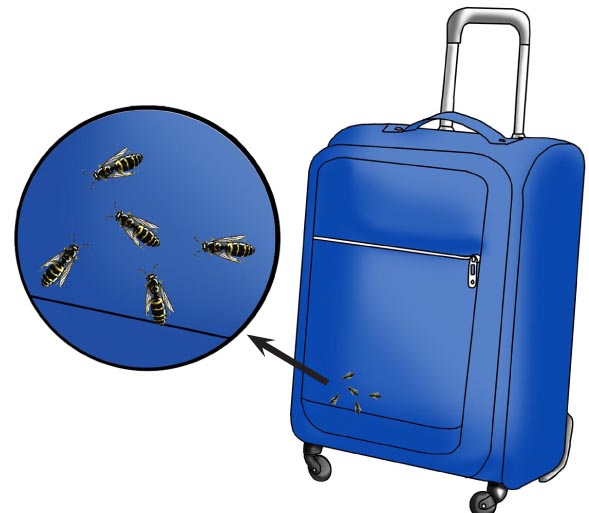

Scientific Phenomena
For years, dogs have been trained to sniff out drugs hidden in traveler’s baggage. Now biological engineers at the University of Georgia have discovered that wasps can do it just at well, without the dog biscuits. The wasps are trained so that when they smell the drugs, they will be fed. After that, whenever the wasp’s sensitive antennae detect the odor of drugs, the wasps react like they are about to be fed.
The wasps are kept in a small, hand-held canister so they can be brought on site for drug sniffing. Wasps only live for about two days, so new wasps have to be brought in and trained (training only take about ten minutes) regularly.
Scientists have shown that wasps can also be used to sniff out bombs, toxins or even dead bodies.
(Kruglinski, Susan. “ Cop Wasps vs. Drug Smugglers.” Discover February 2006: P. 13)
Off site resource from National Geographic News: http://news.nationalgeographic.com/news/2005/10/1027_051027_bombsniffwasps.html

Essential Questions
1. How do humans use artificial selection to use wasps in the detection of drug trafficking?
Disciplinary Core Ideas
LS4.B: Natural Selection: LINK
In artificial selection, humans have the capacity to influence certain characteristics of organisms by selective breeding. One can choose desired parental traits determined by genes, which are then passed on to offspring. (MS-LS4-5)
Science and Engineering Practices
Analyzing and Interpreting Data: Analyze and interpret data to determine similarities and differences in findings.
Using Mathematics and Computational Thinking: Use mathematical representations to support scientific conclusions and design solutions. (MS-LS4-6)
Constructing Explanations and Designing Solutions: Apply scientific ideas to construct an explanation for real-world phenomena, examples, or events.
Obtaining, Evaluating, and Communicating Information: Gather, read, and synthesize information from multiple appropriate sources and assess the credibility, accuracy, and possible bias of each publication and methods used, and describe how they are supported or not supported by evidence.
Crosscutting Concepts
Patterns: Patterns can be used to identify cause and effect relationships
Cause and Effect: Phenomena may have more than one cause, and some cause and effect relationships in systems can only be described using probability.
Connections to Nature of Science
Scientific Knowledge is Based on Empirical Evidence
• Science knowledge is based upon logical and conceptual connections between evidence and explanations. (MS-LS4-1)
Connections to Engineering, Technology and Applications of Science
Interdependence of Science, Engineering, and Technology
• Engineering advances have led to important discoveries in virtually every field of science, and scientific discoveries have led to the development of entire industries and engineered systems. (MS-LS4-5)
Other questions that were generated in researching this Scientific Phenomena?
______________________________________________________________________________
Using Discoveries and Inventions as Scientific Phenomena to Integrate with NGSS:
______________________________________________________________________________
Scientific Phenomena can be used as a tool to anchor a science unit involving a series of lessons to engage in deeper science learning – or what is being called “Three Dimensional Learning”.
1) Describe the phenomena in a way that your students can understand and which sparks their imagination.
2) Create Essential Questions for them to answer to explain the phenomena.
3) Identify the NGSS Disciplinary Core Ideas which you are targeting.
4) Provide clear directions for a process they should use to try to answer the questions using the NGSS Science and Engineering Practices to frame as your guideline.
5) Name the Crosscutting Concepts that students should be aware of throughout the lesson.
6) Discuss the Connections to Nature of Science.
7) Make note of other questions generated in the process of exploring this Scientific Phenomena.